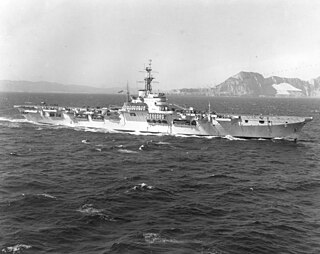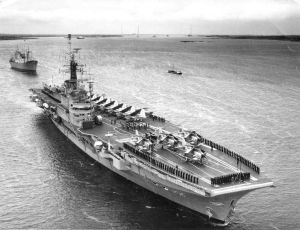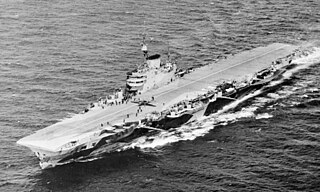
HMS Hermes was a British aircraft carrier built for the Royal Navy and was the world's first ship to be designed as an aircraft carrier, although the Imperial Japanese Navy's Hōshō was the first to be launched and commissioned. The ship's construction began during the First World War but not completed until after the end of the war, delayed by multiple changes in her design after she was laid down. After she was launched, the Armstrong Whitworth shipyard which built her closed, and her fitting out was suspended. Most of the changes made were to optimise her design, in light of the results of experiments with operational carriers.

HMS Warrior was a Colossus-class light aircraft carrier which was ordered in 1942 by the British Royal Navy during World War II. Construction was finished in 1945 and upon completion, the aircraft carrier was loaned to the Royal Canadian Navy from 1946 to 1948 as HMCS Warrior. Warrior was returned to the Royal Navy in 1948 and entered service with the British. While in service with the Royal Navy, Warrior was modernised twice, including the installation of an angled flight deck in 1956. In 1948–1949, the ship was used in aircraft landing experiments and fitted with a rubber flight deck and in 1957, was used as the headquarters ship during nuclear testing at Christmas Island. In 1958, the vessel was sold to the Argentine Navy and entered Argentine service in 1959 as ARA Independencia. The aircraft carrier remained in service until 1970 when Independencia was placed in reserve. The following year, the ship was sold for scrap.

HMS Centaur was the first of the four Centaur-class light fleet carriers of the Royal Navy. She was the only ship of her class to be completed with the original design configuration of a straight axial flight deck, rather than the newly invented angled flight decks of her three later sister ships. She was laid down in 1944 in Belfast, with the contract being awarded to Harland and Wolff, but not launched until 22 April 1947 due to delays relating to the end of the war. She was commissioned on 1 September 1953, a gap of almost nine years from when she was laid down in 1944.

HMS Illustrious was the lead ship of her class of aircraft carriers built for the Royal Navy before World War II. Her first assignment after completion and working up was with the Mediterranean Fleet, in which her aircraft's most notable achievement was sinking one Italian battleship and badly damaging two others during the Battle of Taranto in late 1940. Two months later the carrier was crippled by German dive bombers and was repaired in the United States. After sustaining damage on the voyage home in late 1941 by a collision with her sister ship Formidable, Illustrious was sent to the Indian Ocean in early 1942 to support the invasion of Vichy French Madagascar. After returning home in early 1943, the ship was given a lengthy refit and briefly assigned to the Home Fleet. She was transferred to Force H for the Battle of Salerno in mid-1943 and then rejoined the Eastern Fleet in the Indian Ocean at the beginning of 1944. Her aircraft attacked several targets in the Japanese-occupied Dutch East Indies over the following year before Illustrious was transferred to the newly formed British Pacific Fleet (BPF). The carrier participated in the early stages of the Battle of Okinawa until mechanical defects arising from accumulated battle damage became so severe she was ordered home early for repairs in May 1945.

HMS Formidable was an Illustrious-class aircraft carrier ordered for the Royal Navy before the Second World War. After being completed in late 1940, she was briefly assigned to the Home Fleet before being transferred to the Mediterranean Fleet as a replacement for her crippled sister ship Illustrious. Formidable's aircraft played a key role in the Battle of Cape Matapan in early 1941, and they subsequently provided cover for Allied ships and attacked Axis forces until their carrier was badly damaged by German dive bombers in May.

HMS Indefatigable was one of two Implacable-class aircraft carrier built for the Royal Navy (RN) during World War II. Completed in 1944, her aircraft made several attacks that year against the German battleship Tirpitz, inflicting only light damage; they also raided targets in Norway. The ship was transferred to the British Pacific Fleet (BPF) at the end of the year and attacked Japanese-controlled oil refineries in Sumatra in January 1945 before joining the American forces in March as they prepared to invade the island of Okinawa in Operation Iceberg. Indefatigable and the BPF joined the Americans in attacking the Japanese Home Islands in July and August. Following the end of hostilities she visited ports in Australia, New Zealand and South Africa.

The Implacable-class aircraft carrier consisted of two aircraft carriers built for the Royal Navy during World War II. Derived from the design of the Illustrious class, they were faster and carried more aircraft than the older ships. They were initially assigned to the Home Fleet when completed in 1944 and attacked targets in Norway as well as the German battleship Tirpitz. Subsequently, they were assigned to the British Pacific Fleet (BPF).

HMS Implacable was the name ship of her class of two aircraft carriers built for the Royal Navy during World War II. Upon completion in 1944, she was initially assigned to the Home Fleet and attacked targets in Norway for the rest of the year. She was subsequently assigned to the British Pacific Fleet (BPF) where she attacked the Japanese naval base at Truk and targets in the Japanese Home Islands in 1945. The ship was used to repatriate liberated Allied prisoners of war (PoWs) and soldiers after the Japanese surrender, for the rest of the year. Implacable returned home in 1946 and became the Home Fleet's deck-landing training carrier, a role that lasted until 1950. She briefly served as flagship of the Home Fleet in 1950. During this time she participated in many exercises and made a number of port visits in Western Europe. She was placed in reserve in 1950 and converted into a training ship in 1952, and served as flagship of the Home Fleet Training Squadron. The ship was considered for a major modernisation in 1951–1952, but this was rejected as too expensive and time-consuming. Implacable was decommissioned in 1954 and sold for scrap the following year.

HMS Ark Royal (R09) was an Audacious-class aircraft carrier of the Royal Navy and, when she was decommissioned in 1979, was the Royal Navy's last remaining conventional catapult and arrested-landing aircraft carrier. She was the first aircraft carrier to be equipped with angled flight deck at its commissioning; her sister ship, HMS Eagle, was the Royal Navy's first angle-decked aircraft carrier after modification in 1954. Ark Royal was the only non-United States vessel to operate the McDonnell Douglas Phantom at sea.

The 1942 Design Light Fleet Carrier, commonly referred to as the British Light Fleet Carrier, was a light aircraft carrier design created by the Royal Navy during the Second World War, and used by eight naval forces between 1944 and 2001. They were designed and constructed by civilian shipyards to serve as an intermediate step between the expensive, full-size fleet aircraft carriers and the less expensive but limited-capability escort carriers.

HMS Pioneer was a Colossus-class aircraft carrier built for the Royal Navy during World War II. She was modified whilst under construction into an aircraft maintenance carrier. The ship arrived in Australia in mid-1945 to support operations by the British Pacific Fleet against Japanese forces. She supported the British attacks on the Japanese Home Islands from mid-June until the end of the war in August from a base in the Admiralty Islands. The ship and her facilities were used to help repair Hong Kong's infrastructure in late 1945 and she returned to the UK in early 1946. Pioneer was immediately placed in reserve upon her arrival and she was sold in 1954 for scrap.

The Courageous class, sometimes called the Glorious class, was the first multi-ship class of aircraft carriers to serve with the Royal Navy. The three ships—Furious, Courageous and Glorious—were originally laid down as Courageous-class battlecruisers as part of the Baltic Project during the First World War. While very fast, their minimal armour and few guns limited their long-term utility in the post-war Royal Navy, and they were laid up after the war. They were considered capital ships by the terms of the 1922 Washington Naval Treaty and were included in the total amount of tonnage allowed to the Royal Navy. Rather than scrap them, the Navy decided to convert them to aircraft carriers as permitted under the Treaty.

HMS Courageous was the lead ship of her class of three battlecruisers built for the Royal Navy during the First World War. Designed to support the Baltic Project championed by First Sea Lord John Fisher, the ship was very lightly armoured and armed with only a few heavy guns. Courageous was completed in late 1916 and spent the war patrolling the North Sea. She participated in the Second Battle of Heligoland Bight in November 1917 and was present when the German High Seas Fleet surrendered a year later.

USS St. Simon (CVE-51), an escort aircraft carrier originally classified as an auxiliary aircraft carrier, was laid down on 26 April 1943 at Tacoma, Washington, by the Seattle-Tacoma Shipbuilding Corporation, under a Maritime Commission contract ; reclassified as an escort aircraft carrier, CVE-51, on 15 July 1943; launched on 9 September 1943; sponsored by Mrs. R. H. Lewis, the wife of Major General R. H. Lewis, Commanding General, Northwestern Sector, Fort Lewis, Washington; assigned to the Commercial Iron Works, Portland, Oregon, for the completion of construction; and delivered to the Royal Navy, under lend-lease, on 31 December 1943.

HMS Furious was a modified Courageous-class battlecruiser built for the Royal Navy (RN) during the First World War. Designed to support the Baltic Project championed by the First Sea Lord, Lord Fisher, the ship was very lightly armoured and designed with a main battery of only two 18-inch guns. Furious was modified as an aircraft carrier while under construction. Her forward turret was removed and a flight deck was added in its place, such that aircraft had to manoeuvre around the superstructure to land. Later in the war, the ship had her rear turret removed and a second flight deck installed aft of the superstructure, but this was less than satisfactory due to air turbulence. Furious was briefly laid up after the war before she was reconstructed with a full-length flight deck in the early 1920s.

HMS Argus was a British aircraft carrier that served in the Royal Navy from 1918 to 1944. She was converted from an ocean liner that was under construction when the First World War began and became the first example of the standard pattern of aircraft carrier, with a full-length flight deck that allowed wheeled aircraft to take off and land. After commissioning, the ship was involved for several years in the development of the optimum design for other aircraft carriers. Argus also evaluated various types of arresting gear, general procedures needed to operate a number of aircraft in concert and fleet tactics. The ship was too top-heavy as originally built and had to be modified to improve her stability in the mid-1920s. She spent one brief deployment on the China Station in the late 1920s before being placed in reserve for budgetary reasons.

HMS Eagle was an early aircraft carrier of the Royal Navy. Ordered by Chile during the South American dreadnought race as the Almirante Latorre-class battleship Almirante Cochrane, she was laid down before World War I. In early 1918 she was purchased by Britain for conversion to an aircraft carrier; this work was finished in 1924. Her completion was delayed by labour troubles and the possibility that she might be repurchased by Chile for reconversion into a battleship, as well as the need for comparative trials to determine the optimum layout for aircraft carriers. The ship was initially assigned to the Mediterranean Fleet and then later to the China Station, spending very little time in home waters other than for periodic refits.

HMS Unicorn was an aircraft repair ship and light aircraft carrier built for the Royal Navy in the late 1930s. She was completed during World War II and provided air cover over the amphibious landing at Salerno, Italy, in September 1943. The ship was transferred to the Eastern Fleet in the Indian Ocean at the end of the year. Unicorn supported the aircraft carriers of the fleet on their operations until the British Pacific Fleet (BPF) was formed in November 1944. She was transferred to Australia in early 1945 to support the BPF's operations during Operation Iceberg, the Allied invasion of Okinawa in May. To shorten the time required to replenish the BPF's carriers, the ship was based in the Admiralty Islands and in the Philippine Islands until the Japanese surrender in August. Unicorn was decommissioned and placed in reserve when she returned to the UK in January 1946.

HMS Vindictive was a warship built during the First World War for the Royal Navy (RN). Originally designed as a Hawkins-class heavy cruiser and laid down under the name Cavendish, she was converted into an aircraft carrier while still being built. Renamed in 1918, she was completed a few weeks before the end of the war and saw no active service with the Grand Fleet. The following year she participated in the British campaign in the Baltic against the Bolsheviks during which her aircraft made numerous attacks against the naval base at Kronstadt. Vindictive returned home at the end of the year and was placed in reserve for several years before her flight decks were removed and she was reconverted back into a cruiser. The ship retained her aircraft hangar and conducted trials with an aircraft catapult before she was sent to the China Station in 1926. A year after her return in 1928, she was again placed in reserve.

The Royal Navy built three aircraft maintenance carriers for its Fleet Air Arm before and during World War II. The Abyssinia Crisis of 1934–35 demonstrated to the Admiralty that it needed a depot ship to support the aircraft carriers in active service, just like submarine and destroyer tenders supported those types. Begun just before the start of World War II in 1939, HMS Unicorn was the first ship built in any navy that could "carry out the full range of aircraft maintenance and repair work in addition to the ability to operate aircraft from the flight deck". Unicorn proved the value of the concept and two similar support ships, Perseus and Pioneer were converted into aircraft maintenance ships by modifying light carriers while still under construction. Unlike Unicorn, neither Pioneer nor Perseus were able to land aircraft; they had to be craned aboard.




















